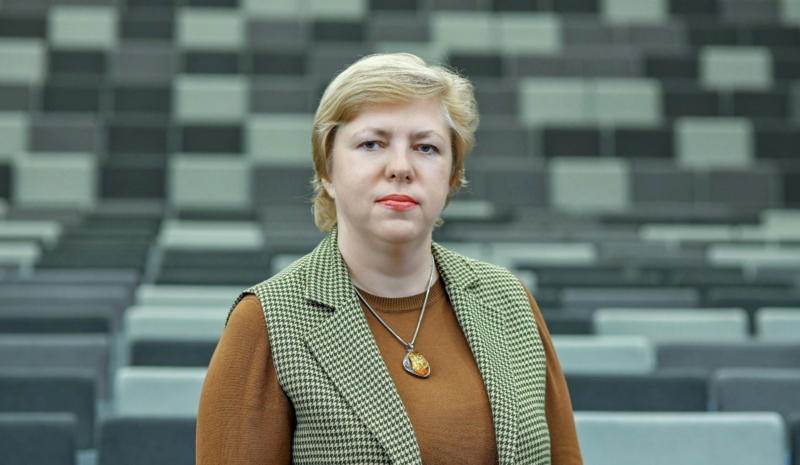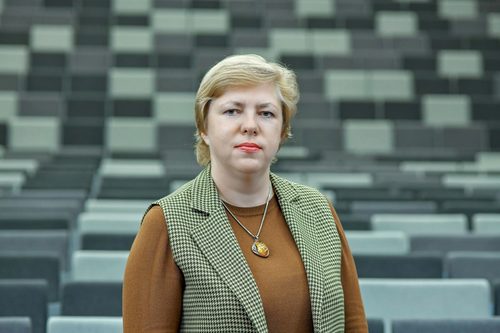- Programmes in English 2025/2026
- Admission 2025/2026 Scholarships
- For exchange students
- Free Movers
- Transfer studies
- Erasmus+ studies and traineeships
- Mentor programme
- Student testimonials
- Accommodation
- Career Services
- Medical Care
- Immigration Regulations
- Leisure and Student Activities
- Useful information
- VILNIUS TECH for Creators of Tomorrow
- Mental and spiritual support
- Representatives Abroad
- Contacts
- Computer Engineering
.png)
2023-12-04
N. Lepkova: "Only speaking to the audience is no longer enough."
Smartphones or laptops are often still seen by educators as adversaries of education. However, as the needs of each generation of students change, so do the teaching methods of many teachers and lecturers that start incorporating these technologies.
We discuss how and what educational technologies are used at Vilnius Gediminas Technical University (VILNIUS TECH) with Assoc. Prof. Dr. Natalija Lepkova, a lecturer at the Civil Engineering.
A lot of tools, a lot of challenges
This year, in the VILNIUS TECH Best Teachers Awards, Assoc. Prof. Dr. N. Lepkova was recognized as a Leader in Educational Technologies. She was recognised for her constant efforts to find ways to actively engage students during classes using technology, which also led to rapid improvement in digital competency.
"Educational technologies involve the application of innovative methods in the learning process, developing the learner's critical thinking, problem-solving, and creativity. This is achieved through the use of computer hardware, software, and the application of educational theories as well as practices to facilitate learning," explains the lecturer with 23 years of teaching experience.
In her lectures, Assoc. Prof. Dr. N. Lepkova uses the Flipped Classroom method (an interactive and mixed learning method that focuses on individual and active learning rather than traditional group learning) and tools such as the digital collaboration platform "Miro," the gamified learning platform "Kahoot," the content creation tool "H5P" for crosswords, cards, the interactive learning application "Mentimeter," and others. By using these tools, the learning process also transforms as tasks are appropriately adapted, which leads to increased student engagement.
Assoc. Prof. Dr. N. Lepkova gradually started using all these tools at VILNIUS TECH, first attending various training sessions organized by the university and also learning independently. She is grateful to the VILNIUS TECH Academic Support Center, the Educational Competencies Group, and the Electronic Studies Group for the provided opportunities and support.
"This is interesting, but also a challenge. There are difficulties as you have to try a variety of tools. If you get the free online ones, they always need to be checked, especially the added functions and changes made. Free tools usually have limited functions. When using MOODLE, you just need to get comfortable using its tools," says Assoc. Prof. Dr. N. Lepkova.
By using various educational technologies, the preparation for lectures also changes. According to the lecturer, it takes a lot of time to select tools and prepare materials. However, this also adds a creative aspect because the course is structured in a completely different way. Moreover, it encourages a continuous improvement for both teachers and students.
Student appreciation
When introducing new tools during lectures, it is important to consider how students perceive them. Assoc. Prof. Dr. N. Lepkova states that it always depends on the group.
"Generally, students like these tools. For students for whom these technologies are applied in teaching and learning it it generally more appealing as they deepen their knowledge through different methods, learning how to practically apply various tools. However, everything must be used in moderation," emphasizes Assoc. Prof. Dr. N. Lepkova.
One of the most important reasons why Assoc. Prof. Dr. N. Lepkova started using educational technologies is the generational shift. According to her, modern students prefer interactive lectures, so the lecturer also has to adapt.
"It is simply necessary to use educational technologies during lectures because the student generation is changing. Speaking alone to the audience is no longer enough. During my student years, teachers simply did not have such opportunities, and since the beginning of my teaching, various technologies have emerged that did not exist before. Nowadays, we have all the possibilities for that. However, there will always be obstacles, one of them being the reluctance of teachers to invest their time, which is indeed required to serve this purpose," says Assoc. Prof. Dr. N. Lepkova.
Photos by Aleksas Jaunius.
A lot of tools, a lot of challenges
This year, in the VILNIUS TECH Best Teachers Awards, Assoc. Prof. Dr. N. Lepkova was recognized as a Leader in Educational Technologies. She was recognised for her constant efforts to find ways to actively engage students during classes using technology, which also led to rapid improvement in digital competency.
"Educational technologies involve the application of innovative methods in the learning process, developing the learner's critical thinking, problem-solving, and creativity. This is achieved through the use of computer hardware, software, and the application of educational theories as well as practices to facilitate learning," explains the lecturer with 23 years of teaching experience.
In her lectures, Assoc. Prof. Dr. N. Lepkova uses the Flipped Classroom method (an interactive and mixed learning method that focuses on individual and active learning rather than traditional group learning) and tools such as the digital collaboration platform "Miro," the gamified learning platform "Kahoot," the content creation tool "H5P" for crosswords, cards, the interactive learning application "Mentimeter," and others. By using these tools, the learning process also transforms as tasks are appropriately adapted, which leads to increased student engagement.
Assoc. Prof. Dr. N. Lepkova gradually started using all these tools at VILNIUS TECH, first attending various training sessions organized by the university and also learning independently. She is grateful to the VILNIUS TECH Academic Support Center, the Educational Competencies Group, and the Electronic Studies Group for the provided opportunities and support.
"This is interesting, but also a challenge. There are difficulties as you have to try a variety of tools. If you get the free online ones, they always need to be checked, especially the added functions and changes made. Free tools usually have limited functions. When using MOODLE, you just need to get comfortable using its tools," says Assoc. Prof. Dr. N. Lepkova.
By using various educational technologies, the preparation for lectures also changes. According to the lecturer, it takes a lot of time to select tools and prepare materials. However, this also adds a creative aspect because the course is structured in a completely different way. Moreover, it encourages a continuous improvement for both teachers and students.
Student appreciation
When introducing new tools during lectures, it is important to consider how students perceive them. Assoc. Prof. Dr. N. Lepkova states that it always depends on the group.
"Generally, students like these tools. For students for whom these technologies are applied in teaching and learning it it generally more appealing as they deepen their knowledge through different methods, learning how to practically apply various tools. However, everything must be used in moderation," emphasizes Assoc. Prof. Dr. N. Lepkova.
One of the most important reasons why Assoc. Prof. Dr. N. Lepkova started using educational technologies is the generational shift. According to her, modern students prefer interactive lectures, so the lecturer also has to adapt.
"It is simply necessary to use educational technologies during lectures because the student generation is changing. Speaking alone to the audience is no longer enough. During my student years, teachers simply did not have such opportunities, and since the beginning of my teaching, various technologies have emerged that did not exist before. Nowadays, we have all the possibilities for that. However, there will always be obstacles, one of them being the reluctance of teachers to invest their time, which is indeed required to serve this purpose," says Assoc. Prof. Dr. N. Lepkova.
Photos by Aleksas Jaunius.













